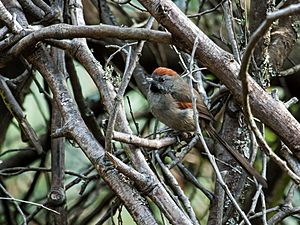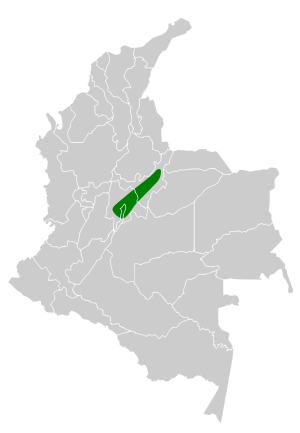Silvery-throated spinetail facts for kids
Quick facts for kids Silvery-throated spinetail |
|
|---|---|
 |
|
| Conservation status | |
| Scientific classification | |
| Genus: |
Synallaxis
|
| Species: |
subpudica
|
 |
|
The silvery-throated spinetail (Synallaxis subpudica) is a small bird that lives in the forests of Colombia. It's part of the Furnariidae family, which includes many birds found in Central and South America. This special bird is found only in Colombia, meaning it is endemic to that country.
Contents
About the Silvery-throated Spinetail
The silvery-throated spinetail is a type of bird known for its long, pointed tail feathers. These birds are usually quite small and often hard to spot because they live in dense forests. They are named for the silvery color on their throat, which helps identify them.
Where Does It Live?
This bird makes its home in the mountains of Colombia. It prefers what are called subtropical or tropical moist montane forests. These are forests found in high, wet mountain areas. It can also live in areas where forests have been cut down but are slowly growing back. This shows it can adapt to some changes in its environment.
What Does It Look Like?
The silvery-throated spinetail is a small bird, usually about 15 to 17 centimeters (about 6-7 inches) long. It has a mostly brown body. Its most noticeable feature is the pale, silvery patch on its throat, which gives it its name. It also has a reddish-brown cap on its head and a long, spiky tail.
What Does It Eat?
Like many small forest birds, the silvery-throated spinetail mainly eats insects. It searches for tiny bugs and other invertebrates among the leaves and branches of trees and bushes. This helps keep insect populations in check within its habitat.
Its Conservation Status
The silvery-throated spinetail is currently listed as a species of "Least Concern" by the International Union for Conservation of Nature (IUCN). This means that, for now, its population is stable and not at high risk of disappearing. However, like many forest birds, it could be affected by habitat loss if its forest homes are cut down. Protecting its natural habitat is important for its future.
See also
 In Spanish: Pijuí de Cundinamarca para niños
In Spanish: Pijuí de Cundinamarca para niños


